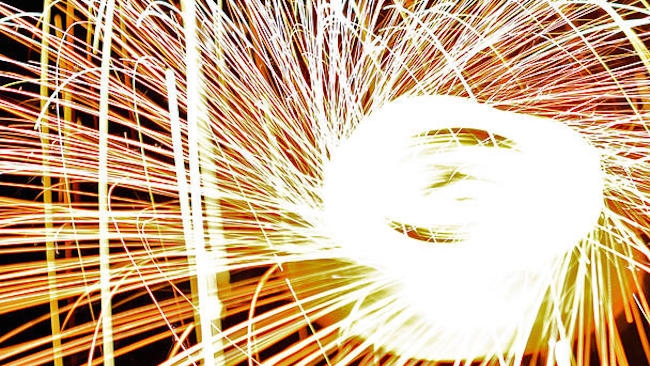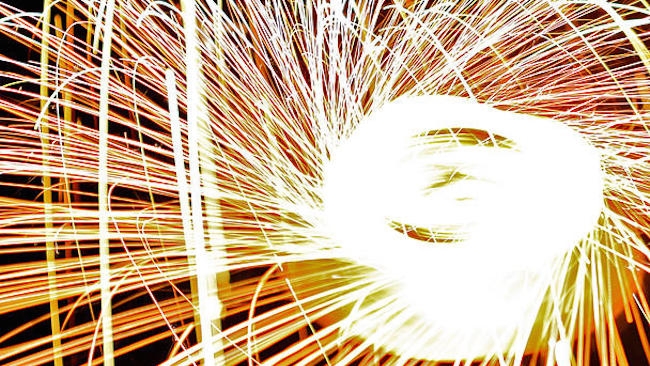
 Wire wool + vintage fan blade = sparks
Wire wool + vintage fan blade = sparks
If you haven’t come across Joe Schenkenberg (better known as Joey Shanks) and his PBS Digital Studios show Shanks FX, it’s perhaps time you did as it is a fairly awesome How To mix of home-brew practical effects using household items and digital refinement.
We have to confess we came across North Carolina-based Mr Shanks though some PR released from Red Giant (which we’ll reproduce after the break by way of saying thanks), but regardless of the route it’s a good story involving gas giants made with LED lights and an electric fan and all that sort of thing.
To cut a long story short, essentially Schenkenberg wanted to make a an experimental short film called Sci-Fly which would recreate all manner of cosmic effects in a home-brew/garage-days sort of manner. And, as one does, he listed it on Kickstarter to get funds. There it proved rather popular, he started posting behind the scenes material showcasing how he created some of the effects, and PBS offered him a web series on the back of it, where it has proved somewhat popular.
Anyway, to catch episodes such as ‘Magnetic Putty Magic’, ‘Ghostbusters Proton Streams’ and the simply fantastic sounding ‘Giant Bubble Explosions’ head over to the Shanks FX site at www.moviemagicnow.com. And to read the full story of Joey and what he does, catch Red Giant is an Important Ingredient in PBS Digital Studios Hit Show after the break.
Red Giant is an Important Ingredient in PBS Digital Studios Hit Show
Joe Schenkenberg, better known as Joey Shanks, is a digital illusionist of sorts. Every day, he works with magical magnetic putty, giant bubble explosions, technicolor teleportation effects and more to produce some of the most hypnotic visual effects on YouTube, Vimeo and recently, PBS Digital Studios – all of which he refines with Red Giant effects.
Joey first discovered his love for filmmaking during college in 2002. While he was not a film major, he and his friends would make films in their spare time. He realized quickly that the art of visual storytelling was an important outlet for his creativity, a passion that he would turn into a lifelong career.
Joey started capturing everything on camera that he could, creating visual effects out of anything from salt shakers to hydrogen peroxide. Eventually, he got good at it. So good that his first ever stop motion film, “Wiggle Room,” won the award for “Best Animated Short” at multiple film festivals. Most notably, it took first in the USA Film Festival, qualifying Joey to submit it to the Academy Awards for the year’s best animated short.
His next big idea was an experimental short film called “Sci-Fly.” It would include cosmic elements created in-camera using household objects, paying homage to older science fiction films that have since become cult classics. To raise funds, Joey launched a Kickstarter campaign. The “Sci-Fly” campaign was so successful that it was featured on Kickstarter’s homepage, and Joey’s audience expanded astronomically.
To thank donors and to up the ante, Joey started posting behind-the-scenes promotional material to the campaign site. Little did he know that his backers weren’t the only ones keeping an eye on his visual effects.
At the time, PBS Digital Studios was in the process of opening its new studio and was looking for programming. A representative saw Joey’s campaign and behind-the-scenes work, and immediately contacted him to ask if he’d develop a web series for PBS.
“There’s not really a huge demand for what I do, but I’m able to present it in a way where people are interested in watching it,” Joey says of his one-of-a-kind job. “It’s really important for me to feel that no one’s ever tackled this subject, that an effect has never been captured this way, to get me interested in pursuing it. I like coming up with a concept that I know is really original and making it work.”
The concept Joey and PBS came up with was a web series called “Shanks FX,” which is based on Joey’s love for creating visual effects with household items. It is an expansion of the behind-the-scenes visuals he was creating on projects such as “Sci-Fly,” only this time, the behind-the-scenes shots actually make up the entire series. Dedicating each episode to the art of creating homemade visual effects, viewers can experience the filmmaking magic firsthand. Joey works constantly to create new effects with his own spin, and “Shanks FX” documents his journey.
“I wanted to make videos that were fun to watch. Regardless of the intent, I have always taken the post part of the filmmaking process really seriously, and put in an endless amount of time into editing, sound design and effects to make sure the work looks great,” Joey says.
To keep his videos and PBS episodes unique and visually appealing, Joey started using Red Giant’s Magic Bullet suite of visual effects plug-ins. A fan and user of Red Giant software since 2005, Joey takes his homemade effects to the next level by incorporating subtle digital effects.
“I’ve always tried to make my effects as good as I can in-camera, but the good thing with Red Giant is, with all the effects they offer, you can subtly enhance what you have shot. I can bring out the colors to make shots pop a little bit more,” he says. “You’d never know I use any filters on a lot of the content I put out, but it’s these subtle enhancements that make the stars shine a little bit brighter, or the colors come out a little bit more. I use Red Giant plug-ins on just about every project I produce.”
Red Giant’s Trapcode Suite is a regular on Joey’s desktop, as the 3D effects, especially Particular (the industry-standard particle system for Adobe After Effects), allow him to fill out many of his homemade ones. “A lot of the time, I’m trying to make my visuals look grand and epic in scale. Sometimes what I capture ‘in-camera’ doesn’t always have that larger-than-life feel; Trapcode allows me to fill in the gaps to create a fully realized composite.”
Using Trapcode Particular, Joey is able to fill out his DIY holograms, which he says originally lacked color and the necessary vapor particles that give them a more realistic and visually appealing look. When creating his cosmic backdrops for “Creating the Cosmos” (the episode and effect Joey is most proud of), he finds he always seems to want more stars, and just adding a handful of tiny stars at varying depths and sizes in Particular really makes the shot come together.
For the Shanks FX episode “Illusion of Spaceflight,” Joey created cloud particles that, when placed by the camera, created a feeling of movement. He says, “I blurred them out so much you don’t even know they are there, but it makes all the difference for creating a sense of movement and dimension."
A lot of the Shanks FX episodes deal with light painting techniques, so Joey will blend in digitally recreated light streaks using Trapcode just to add more of a “wow” factor. Since he’s combining the effect with pre-existing light streaks, viewers can’t tell what’s digital and what’s created in-camera – but it always looks unique. “It’s not digital, it’s not practical, it’s a hybrid that helps my work stand out from everyone else.”
Joey has used Red Giant on his entire PBS series, even adding the recently released Red Giant Universe to his arsenal of visual effects options. He has a vast array of customized presets, and depending on the effect he’s going for, he checks and unchecks certain boxes to add minute distinctions.
Because Joey can customize the look and feel of his videos so seamlessly, he is able to focus more on his level of creativity rather than technicalities. On his latest video “Rebuilding the INTERSTELLAR Black Hole,” he used his custom-made “Interstellar Black Hole filter,” a preset that combines three Universe plug-ins: Holomatrix, Carousel and Masked Blur. The look is designed to give off a film/Instagram vibe, but he was able to take the time to pick and choose what elements of the plug-ins he wanted to use.
By customizing the plug-in settings to create more subtle, natural effects, Joey was able to make certain the red fire elements in his video really glowed and popped, and the effect became something completely its own. Red Giant’s plug-ins give Joey the power to put as much as he wants into the effect, and unlike many other tools, they don’t dictate what his film is going to look like. The in-depth adjustment controls allow him to determine that himself.
Joey also loves that he can access his work and use Red Giant on both his PC and his Mac through Premiere, After Effects and Final Cut Pro, as he often switches between multiple platforms to assemble the projects.
“Red Giant products play nice with every major editing tool out there – it’s one of the few that still does,” Joey says. “The workflow is great. I can preview effects on the fly, which is really important to me. A lot of times with effects and plug-ins, I find that if it’s taking me forever to get a sample, I’m not even going to bother, regardless of how good it’s going to look. That’s the great thing about Red Giant; every effect is very customizable, and you can see what it’s going to look like very quickly, so I never have issues with slow render speeds that might hinder my process.”
Beyond PBS
With a resume of impressive projects, Joey has been tapped to do a course on special effects for the Stan Winston School, an educational institution known for its expertise in visual effects education. Launching on January 20th, the 8-hour web course focuses on creating the cosmos, creating your own holograms and creating reverse motion effects.
This past summer, Joey acted and was the practical effects supervisor for Matt Johnson’s (The Dirties) next feature film “Operation Avalanche,” which is set in 1969 and centers around a couple of spies who infiltrate NASA and break into Stanley Kubrick’s 2001 movie set and steal his “Front Screen Projection” secrets to help fake the moon the landing for the US government. Joey is one of the few people left who still knows how to produce “Front Screen Projection” effects. See how he does it in this episode of Shanks FX.
Always keeping busy, Joey has been doing test shots for an IMAX feature film concept that deals with a space race around our solar system a la “Around the World in 80 days.” Joey explains, “Think ‘Gravity’ meets the X-Games, where all the locations and scenarios still follow scientifically recorded data and reference existing imagery. It won’t be fiction, just a very optimistic outlook on how our technology will develop over the next 300 years.”
Joey even campaigned to finish the unfinished Terrence Malick IMAX film “Voyage of Time,” which would have contained many segments from “The Tree of Life” creation sequence. “A life-changing experience when I first watched it – it was the main inspiration for ‘Sci-Fly’!”
For all his projects, it’s clear that Joey will be taking Red Giant along for the journey. “I love how they’re constantly upgrading and expanding their tools, like Universe,” Joey says. “Red Giant is always going to be evolving to stay up to date. They understand that in today’s society, things are always changing, and you’re going to be able to follow the change and evolve with the Red Giant package.”
Tags: Post & VFX


Comments